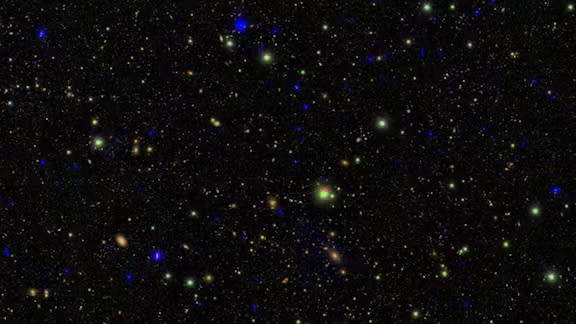When you buy through links on our articles, Future and its syndication partners may earn a commission.


This article was originally published at The Conversation. The publication contributed the article to Space.com’s Expert Voices: Op-Ed & Insights. Fan Zou is a graduate student at Penn State University while W. Neil Brandt is a professor of astronomy and astrophysics at Penn State.
Black holes are remarkable astronomical objects with gravity so strong that nothing, not even light, can escape them. The most gigantic ones, known as “supermassive” black holes, can weigh millions to billions times the mass of the Sun.
These giants usually live in the centers of galaxies. Our own galaxy, the Milky Way, contains a supermassive black hole in its heart as well.
So, how do these supermassive black holes become super massive? To answer this question, our team of astrophysicists looked back in time across the universe’s 13.8 billion-year history to track how supermassive black holes have grown from the early days to today.
We constructed a model of the overall growth history of supermassive black holes spanning the past 12 billion years.
How do supermassive black holes grow?


Supermassive black holes grow primarily in two ways. They can consume gas from their host galaxies in a process called accretion, and they can also merge with each other when two galaxies collide.
When supermassive black holes consume gas, they almost always emit strong X-rays, a type of high-energy light invisible to the naked eye. You’ve probably heard of X-rays at the dentist, where they are sometimes used to examine your teeth. The X-rays used by astronomers generally have lower energies than medical X-rays.
So how can any light, even invisible X-rays, escape from black holes? Strictly speaking, the light is not coming from the black holes themselves, but from the gas just outside them. When gas gets pulled toward a black hole, it heats up and shines to produce light, like X-rays. The more gas a supermassive black hole consumes, the more X-rays it will produce.
Thanks to the data accumulated over more than 20 years from three of the most powerful X-ray facilities ever launched into space – Chandra, XMM-Newton and eROSITA – astronomers can capture X-rays from a large number of accreting supermassive black holes in the universe.
This data allows our research team to estimate how fast supermassive black holes grow by consuming gas. On average, a supermassive black hole can consume enough gas to amount to about the mass of the sun each year, with the exact value depending upon various factors.
For example, the data shows that a black hole’s growth rate, averaged over millions of years, is strongly connected to the mass of all the stars in its host galaxy.
How often do supermassive black holes merge?
Besides feeding on gas, supermassive black holes can also grow by merging with each other to form a single, more massive black hole when galaxies collide.
Supercomputer cosmological simulations can predict about how often these events happen. These simulations aim to model how the universe grows and evolves over time. The countless galaxies flying through space are kind of like bricks, building up the universe.
These simulations show that galaxies and the supermassive black holes they host can undergo multiple mergers across the span of cosmic history.
Our team has tracked these two growth channels – gas consumption and mergers – using X-rays and supercomputer simulations, and then combined them to construct this overall growth history, which maps the growth of black holes across the universe over billions of years.
Our growth history revealed that supermassive black holes grew much faster billions of years ago, when the universe was younger.
Back in the early days, the universe contained more gas for supermassive black holes to consume, and supermassive black holes kept emerging. As the universe aged, the gas was gradually depleted, and supermassive black hole growth slowed. About 8 billion years ago, the number of supermassive black holes stabilized. It hasn’t increased substantially since then.
When there isn’t enough gas available for supermassive black holes to grow by accretion, the only way for them to get larger is through mergers. We didn’t see very many cases of that in our growth history. On average, the most massive black holes can accumulate mass from mergers at a rate up to the mass of the sun every several decades.
Looking forward
RELATED STORIES:
— How do some black holes get so big? The James Webb Space Telescope may have an answer
— Brightest quasar ever seen is powered by black hole that eats a ‘sun a day’
—Record breaker! Milky Way’s most monstrous stellar-mass black hole is sleeping giant lurking close to Earth (Video)
This research has helped us understand how over 90% of the mass in black holes has accumulated over the past 12 billion years.
However, we still need to investigate how they grew in the very early universe to explain the remaining few percentages of the mass in black holes. The astronomical community is starting to make progress exploring these early supermassive black holes, and we hope to find more answers soon.
This article is republished from The Conversation under a Creative Commons license. Read the original article.
